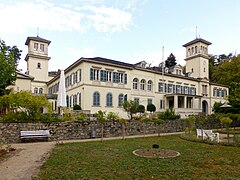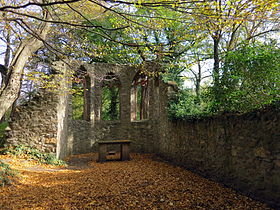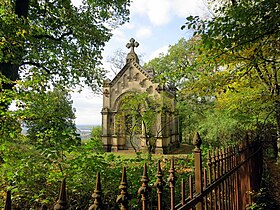Heiligenberg Castle (Jugenheim)
Schloss Heiligenberg is east of Jugenheim , part of Seeheim-Jugenheim , about twelve kilometers south of Darmstadt , just east of the Holy Mountain ( 209 m above sea level. NHN ) from which you have a wide view of the Rhine valley from the Palatinate across to the Taunus has .
lock
After secularization in 1803 and the clarification of outstanding leases from the Lords of Hausen, Heiligenberg, which had been used for agriculture again since 1769, came into the possession of the Hessian court chamber councilor August Konrad Hofmann , who between 1813 and 1816 had an agricultural estate built at the foot of the later Marienberg. The architect and Darmstadt court building director Georg Moller may have already been involved in these plans . During these construction measures, a targeted search was also made for traces of older settlement of the terrain, which, however, remained without findings and led later speculations about Franconian manors at this point to absurdity.
Hofmann sold the estate in 1827 to the then Hereditary Grand Duchess Wilhelmine of Hesse and the Rhine , who used it as a summer residence. When her husband Ludwig became Grand Duke after the death of his father, she had more financial means at her disposal, with which she had the estate expanded into a castle by Georg Moller from around 1831.
Heiligenberg Castle was later inhabited by the third-born son of the grand ducal couple, Prince Alexander of Hesse and near Rhine , and his morganatic wife Princess Julia von Battenberg , who expanded and rebuilt it several times from 1862 over the next five years and then until 1886 - apparently afterwards plans by Georg Moller, who had since died in 1846.
Alexander and Julia became the founders of the Battenberg / Mountbatten family . Due to the extensive dynastic connections of the family, the palace was the center of regular visits by the Russian Tsar couple and a meeting place for kings, princes and diplomats until 1914 . The eldest daughter of the two, Princess Marie Karoline von Battenberg , who was born in Strasbourg in 1852 and later became Princess of Erbach-Schönberg , describes life on the Heiligenberg at that time, the visits of grand dukes and emperors , in the first volume of her three-volume autobiography Crucial Years or the inauguration of the golden cross - but also the structural change, which she partly regretted.
In 1920 Alexander's son, Prince Ludwig Alexander von Battenberg (since 1917 Louis Mountbatten, 1st Marquess of Milford Haven ), got into financial difficulties after his discharge from the Royal Navy in 1918, sold the castle to two investors : privy councilor Dr. Theodor Görges from Berlin and his son-in-law Heinrich Prince von Hohenleuben, before the Hessian state, which had already been brought into line , became the owner in the mid-1930s, supposedly to settle tax debts . First as a Nazi BDM used -Gauführerinnen- and utility school, the castle until the war served as a substitute hospital .
After the Second World War and a renovation of the interior, the complex housed various technical schools and institutions for decades ; most recently it was the seat of the Office for Teacher Education until 2011 . A wedding room for the Seeheim-Jugenheim community has been set up in the castle since 2012. The garden hall and the castle courtyard are regularly used for art exhibitions and concerts. The castle was taken over by a foundation in 2012 to protect art and culture. Since 2014 the “Juremer Curb” has also been opened here. In 2015 a Christmas market took place in the castle courtyard for the first time.
Pedagogical Institute Jugenheim
From 1946 to 1963 the Jugenheim Pedagogical Institute existed in the palace for elementary and secondary school teacher training in Hesse, which had been relocated from Darmstadt at the end of 1945 due to the lack of space there (hence also PI Darmstadt-Jugenheim ). The US occupation forces wanted to address the shortage of teachers as quickly as possible and ensure democratic teacher training . The formative leader and director until 1961 was the political scientist Friedrich Trost , another well-known professor Martin Wagenschein , who describes the idyllic atmosphere in his memories. Walter Asmus moved here from PI Weilburg in 1954. Many well-known scholars began their careers with teaching positions in Jugenheim: Heinz-Joachim Heydorn , Ludwig Neundörfer , Georg Geißler , Ernst Fraenkel . The students included Margarete Dierks , Norbert Groddeck , Ursula Wölfel . The school village Bergstrasse nearby was founded by the institute. The last director was the philosopher and educational scientist Hans-Michael Elzer , under whom the institute was closed in 1963 after the University of Education (HfE), founded in Frankfurt am Main in 1960/61, took over the training for teaching positions at elementary and secondary schools. The HfE was integrated into the Goethe University Frankfurt in 1967 as a department for educational science (AfE) .
Surroundings
- The park surrounding the palace has only been landscaped again for a few years, but the Heiligenberg Jugenheim Foundation has had a park maintenance facility created, which is gradually being implemented. The visitor can still hardly overlook the stately incense cedar (Calocedrus) in front of the main building or the sequoia tree (Sequoioideae) by the pond; Other plants that are still exotic today can be recognized by the trained eye on the Heiligenberg. Bit by bit, the former park design becomes visible again in the surroundings. The original park spanned a much larger area than can be seen today, was designed much more openly and flowed into the surrounding landscape of the northern mountain road .
- The Heiligenberg monastery ruins : In the immediate vicinity are the remains of the small monastery, which was probably built as an own monastery of the Lords of Bickenbach to care for unmarried or widowed female family members at the latest at the beginning of the 12th century. In 1413, the Archbishop of Mainz , Johann von Nassau-Wiesbaden-Idstein, incorporated the nunnery on the grounds that his income could no longer guarantee an independent continued existence, the Lorsch monastery , which from now on also paid the pastor in the Jugenheim church and appointed a provisional in the monastery . The two remaining nuns were forbidden in the certificate of incorporation to accept new members in their convent. The monastery was used for over a century - as u. a. A regest from 1493 in the Darmstadt State Archives proves that Eberhard Scheubel was appointed pastor in the Heiligenberg Monastery. After the Reformation moved into the Electoral Palatinate and the secularization of the Lorsch Monastery, it continued to operate as part of the domain. At the latest after the looting in the Thirty Years War , the monastery buildings began to decline. As a result, there were some robbery excavations; the Heiligenberg overgrown.
- Centlinde : Right next to it is the Centlinde, which used to be around 1000 years old, today it is estimated to be around 800 years old. The cent court met here from the 13th to the 16th century .
- The landmark of Jugenheim, the Golden Cross , was erected in 1866 to commemorate the former resident Grand Duchess Wilhelmine and inaugurated by her four children on May 28, 1866 (Wilhelminentag). It stands on a base made of black syenite and is about eight and a half meters high. With its gold leaf it can be seen from afar from the Rhine plain .
- Next to the cross is the von Battenberg family's mausoleum, completed in 1894 . It was built for Prince Alexander († 1888) and his wife Julia († 1895). After the two were reburied in a brick crypt under the burial place in front of the golden cross in 1902, the mausoleum was rededicated as the memorial chapel of the Battenberg family. There is also a memorial stone on the grave for her grandson Louis Mountbatten , who was murdered by the IRA in 1979 .
The cross, mausoleum and center linden tree can only be viewed by appointment.
Artificial ruin with original Gothic tracery from Bensheim-Gronau was built in 1830 on the foundations of the Romanesque chapel choir.
Regular events
- last weekend in August: opening of the "Juremer Curb" on Friday evenings
- November, December: Christmas and crafts market
Individual evidence
- ^ Heiligenberg, Darmstadt-Dieburg district. Historical local lexicon for Hesse (as of February 17, 2014). In: Landesgeschichtliches Informationssystem Hessen (LAGIS). Hessian State Office for Historical Cultural Studies (HLGL), accessed on June 15, 2014 .
- ^ Princess Marie zu Erbach-Schönberg Princess von Battenberg: Decisive years. 1859-1866-1870. From my childhood and girl days. Second edition. Verlag der "Litera" -A.-G., Darmstadt 1923.
- ↑ Prince Heinrich XXXI. Reuss zu Köstritz (1868–1929) was a son of Prince Heinrich LXXIV. Reuss to Köstritz . As a German diplomat he was ambassador to India (New Delhi) from 1910 to 1912 and envoy to Iran (Tehran) from 1912 to 1916 . From 1918 to 1929 he was morganatically married to Ilse Marie Görges , daughter of Theodor Görges and Ilse Kunheim, and since this marriage he has carried the title of Prince von Hohenleuben . See also the list of family members at Haus Reuss
- ^ Günter Baisch, Claudia Schäfer: Jugenheim - The Heiligenberg and the Battenberger. 2008, p. 37.
- ^ Photo album from July 1934, HStAD inventory R 4 No. EVIDENCE
- ↑ Heiligenberg Castle opens. In: Frankfurter Allgemeine Zeitung . May 16, 2013, p. 48.
- ↑ Ompteda: Rhenish Gardens
- ^ HStAD, A 1, 101/1: Certificate of September 20, 1493: Heiligenberg (monastery): Presentation of Eberhard Scheubel to the pastor in the Heiligenberg monastery near Jugenheim ( digitized in the archive information system Hesse )
- ↑ An application can about the Foundation Heiligenberg Jugenheim done
- ^ Conrad von Weinsberg 1368, Jugenheim. Grave monuments in Hesse until 1650 (as of April 27, 2005). In: Landesgeschichtliches Informationssystem Hessen (LAGIS). Hessian State Office for Historical Cultural Studies (HLGL), accessed on October 9, 2014 .
- ↑ “Juremer Curb” starts on the Heiligenberg In: echo-online.de , accessed on January 31, 2019.
- ↑ Darmstadt Echo . December 11, 2015, p. 18.
literature
- Princess Marie zu Erbach-Schönberg Princess von Battenberg : Decisive years. 1859-1866-1870. From my childhood and girl days. Second edition. Verlag der "Litera" -A.-G., Darmstadt 1923, DNB 574708936 .
- Günter Baisch, Claudia Schäfer: Youth Home - The Heiligenberg and the Battenberger. Edited by the Jugenheim Transport and Improvement Association ad Bergstrasse 1863 eV, Jugenheim 2008, DNB 999995111 .
- Thomas Biller: Castles and palaces in the Odenwald. A guide to history and architecture. Schnell and Steiner, Regensburg 2005, ISBN 3-7954-1711-2 , pp. 62–64.
- Hans Buchmann: Jugenheim, Balkhausen and the Heiligenberg - From the chronicle of the communities Jugenheim and Balkhausen. Published by the Jugenheim transport and improvement association adB, Horn printing company, Jugenheim 1978, DNB 790515377 .
- Egon Caesar Corti : Among tsars and crowned women. The fate and tragedy of European empires on the basis of letters, diaries and secret documents from Tsarina Marie of Russia and Prince Alexander of Hesse . 1-8 Edition. Pustet, Salzburg / Leipzig 1936, DNB 572639899 .
- Rolf Müller (Ed.): Palaces, castles, old walls. Published by the State Chancellery's Hessian Service. Wiesbaden 1990, ISBN 3-89214-017-0 , p. 329.
- Ludwig von Ompteda : Rhenish gardens from the Moselle to Lake Constance: pictures from old and new nurseries . Paul Parey Verlag, Berlin 1886. ( Digitized edition of the University and State Library Düsseldorf .)
- Traffic and Beautification Association Jugenheim ad Bergstrasse 1863 e. V. (Ed.): Jugenheim. The Heiligenberg and the Hessian teacher training. 2nd Edition. Jugenheim dd B. 2010, OCLC 960424636 .
Web links
- Heiligenberg, Darmstadt-Dieburg district. Historical local dictionary for Hessen. In: Landesgeschichtliches Informationssystem Hessen (LAGIS).
- Darmstadt-Dieburg district: Heiligenberg Castle
- Heiligenberg Jugenheim Foundation
- Photo gallery with photos of the castle
- Photo gallery with pictures of the Battenberg mausoleum (inside)
Coordinates: 49 ° 45 ′ 5 ″ N , 8 ° 38 ′ 51 ″ E













